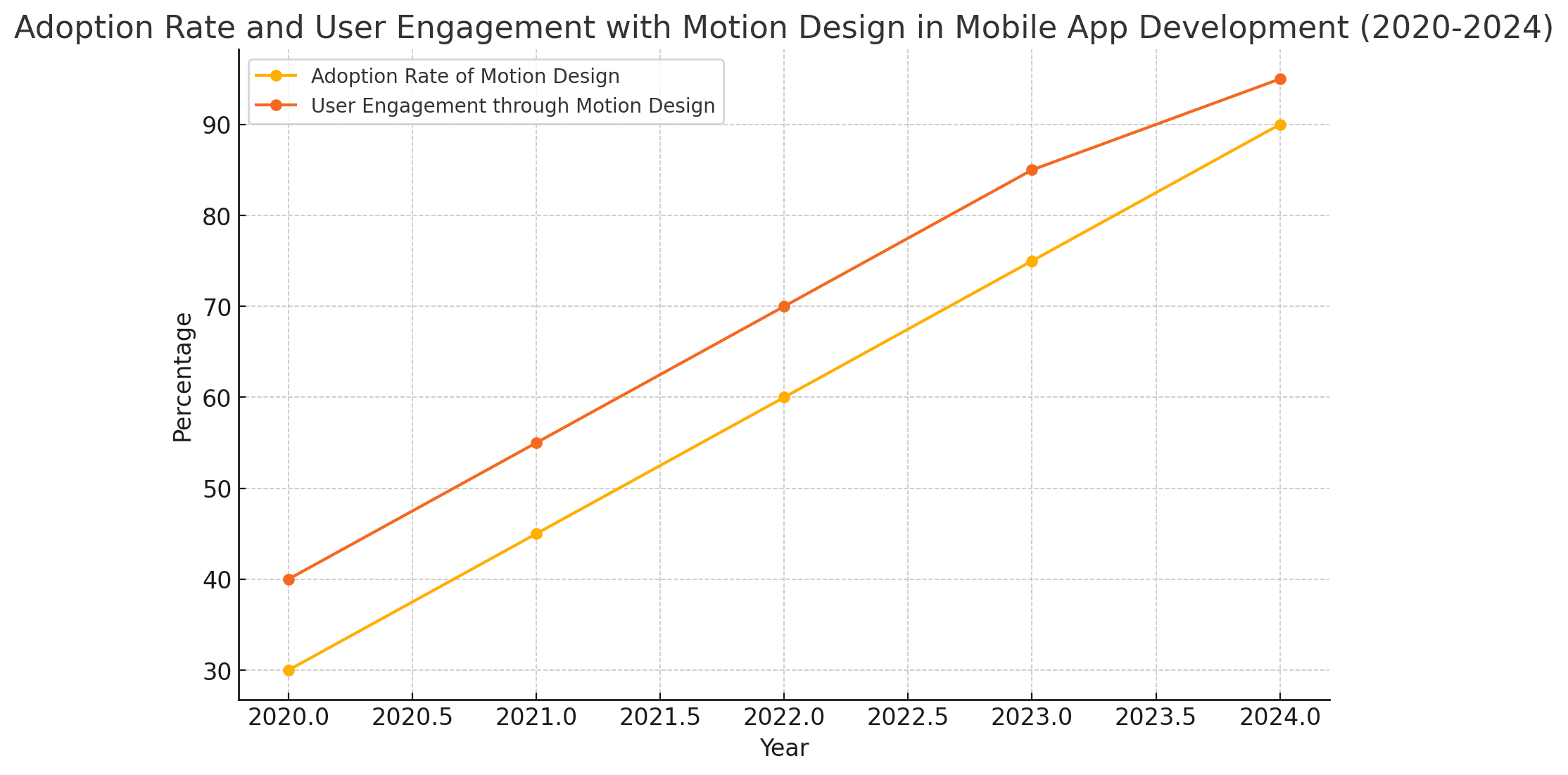The Future of Mobile Apps: Top 15 Mobile App Development Trends for 2024 and Beyond
The mobile app development landscape is evolving rapidly, driven by technological advancements and changing user preferences. As the mobile app market is very close to reaching $614.40 billion by 2026, it is cardinal for the developers as well as the businesses to keep up with the contemporary trends to be able to come up with useful, hi-tech, and competitive apps that will fuel up the correspondingly enhancing the new age users’ experience.
It covers such topics as the major fifteen trends that will affect the future of mobile applications. Among the topics, some of them are motion design, privacy concerns, and potential prospects of foldable gadgets will be highlighted. The topics to be discussed in this blog include the advantages that low code/no code platforms have; the effects that 5G provides for businesses; and well as changes that AR and VR experience. Also, we will touch upon such topics as mobile commerce growth, the introduction of artificial intelligence for personalization, and the enhancement of sites’ accessibility. Other trends include the use of predictive analysis, on-demand applications, camera-centric features, chatbots, cloud, and touchless UI.
Therefore, if you are looking to expand your digital footprint through mobile app development, now is the time to get your hands on the latest mobile app development trends so that you deliver nothing but the best to your customers.
1. Double Down on Motion Design
Motion design for creating dynamic interfaces by adding the animations and effects to the applications is getting more and more important in the mobile applications’ development. This accessibility makes the apps look nice and improves the user experience through the effective feedback and prompts given to users regarding the app.
Considering the changes in technology it may be expected that in future the motion design in mobile application will further evolve and get more complicated. The phenomenon of motion design will continue to grow as application developers find ways of enhancing the look, feel and performance of the applications in equal measures.

The figures in the graph illustrate that the average incorporation of motion design in mobile apps have risen from year 2020 to 2024 increasing user interaction. While paying extra attention to the motion design, the developers are able to design attractive mobile experiences that enhance the satisfactoriness of the interactions with the applications.
2. Privacy Is Getting More Focus
Over the years, the usage and concern about data privacy among users has received a lot of attention in the recent past especially amongst the mobile app users. Data subjects are more conscious of their data and how this is processed, archived, and utilized thus calling for more accounting.
As a result of these emerging social and political issues, the governments and other regulatory authorities in the world are putting in place more comprehensive data protection standards. The enhanced data protection standards like GDPR in Europe and CCPA in USA demands the organization like ours to implement stronger policy to protect the user data.
To maintain privacy in mobile application, the following strategies observed from developers are; Full encryption is growing to be normal as it ensures that data exchanged in between users and applications are safe and non penetrable to third parties. Data obfuscation is the third common where personal identifiable information is either stripped or disguised in some way so that the data cannot be easily associated with the users. Also, there are new features concerning the user data, for example, personalized options and obvious consent options in the apps.
3. Apps for Foldable Devices
Foldable devices, though currently niche in the smartphone market, are poised for growth in the coming years. It’s crucial to factor them into your mobile app development strategy. Ensuring your apps run seamlessly on foldable devices is a challenging trend for 2024.
Expanding the device for a larger screen offers several user benefits
- More space for a detailed and immersive experience.
- Multi-window functionality allows users to multitask effectively.
- Video streaming and gaming apps can maximize the larger screen by enhancing visuals or adding extra information and controls.
Developing apps with foldable screens in mind is set to be a major trend in mobile app development for 2024.
4. Low Code/No Code Development
Low code and no code tools have also emerged in recent years to help users build applications without having to do most of the coding themselves, from within tool-based interfaces. The market for low code platforms is estimated to rise from $13.2 billion in 2021 to $45.5 billion by 2025 and an estimated CAGR of 28.1%. According to marketsandmarkets, By 2026, the low-code development market is projected to reach $44.5 billion, with an annual growth rate of around 20% By FutureCIO, thus improving development velocity. This is according to a Forrester report that shows that these platforms enhance the speed of developers ten times while they focus on other tasks instead of coding. Likewise, no code has also increased the customer satisfaction level citing faster deployment and high customization rate as reported
5. 5G Technology
5G is a new kind of cellular technology that will subdue 4G LTE that connects us to the internet and each other through mobile networks. It makes it possible for mobile applications, to download and upload data at a ten fold speed as compared to other networks facilitating real time experience and streaming of high definition videos. No more minutes or even seconds, 5G helps to improve interactivity based on gaming, online meetings, or IoT devices with the help of milliseconds. It also allows more ‘things’ per area to be connected, enabling novel uses of augmented reality, self-driving cars or tele-medicine. 5G is expected to account for more than 40% of the world’s population by 2025, thus injecting new thinking across different sectors.
6. Augmented Reality (AR) & Virtual Reality (VR)
AR adds the Internet layer on reality with the help of devices such smartphone or AR glasses that enhances the vision of the user. VR places users in a completely dummy world through the VR headsets thereby excluding the real world.
Current Trends and Applications in Mobile Apps
Integrating AR and VR technologies are fairly new in the mobile applications and are rapidly expanding. Global AR market by the end of the year 2023 was of $30 billion. 7 billion, expected to grow up to $88. 4 billion by 2026. Current AR spotted across the retail sector (like Sephora’s Virtual Artist), navigation such as Google Map’s AR and gaming sites such as Pokémon GO. It has been incorporated in gaming, especially in games such as Beat Saber, real estate use for virtual tours, and learning, especially in education.
Future Prospects and Advancements in AR and VR Technologies
The prospects for application of Augmented Reality and Virtual Reality in the field of Mobile applications have of course much potential in the future. The future of Augmented Reality in mobile apps is believed to advance as technology improves and artificial intelligence is incorporated. Virtual Reality will evolve as kit heads for qualitative change to establish more convincing representations. It is believed that both technologies will grow in application in heathcare, tourisim, and skills training of the work force. The precise worth of the market share for VR remains relatively high at $21. 8 billion in 2023 to $184 billion in 2026”, there is no reasoning to disagree with such projections. 6 billion by 2030. The forecast for the further AR development looks promising; by 2025, 1,073 million people are going to use it on their mobile devices.
7. Mobile Commerce
Rise of Mobile Commerce and Its Significance
Mobile commerce or m-commerce is on the rise at the moment. This is a type of e-commerce that is conducted on a mobile gadget.
The mobile ecommerce market size was estimated to be $833. 9 billion back in 2021. It is expected that this will rise to $4,711. 9 billion by 2027, The average growth rate for this period was 46% CAGR.
Mobile retail e-commerce sales are expected to be over $510 billion in the year 2023. A vast majority of these sales will occur on a smartphone. It was only about seven years ago that the mobile commerce split was almost 50/50 between smartphones and tablets. But, currently, smartphones contribute to about 87% of the m-commerce sales.
Features and Functionalities that Enhance Mobile Shopping Experiences
These are some of the key features, which if developed, would improve the mobile shopping experiences:
Mobile Wallets: Mobile wallet offers an entirely new dimension to retail sales to improve their business presence. The mobile wallet market size was valued at $1,043.1 billion in 2019, and is projected to reach $7,580.1 billion by 2027, growing at a CAGR of 28.2% from 2020 to 2027.
One-Click Payments: There is a tendency to use single-click payment systems meaning a simpler purchase process.
Personalized Shopping: Al and analytics personalized selling is enhancing visitors’ conversion and engagement in purchases resulting in high sales.
8. AI-Driven Personalization
Role of Artificial Intelligence in Personalizing User Experiences
Artificial Intelligence (AI) extensively contributes to personalizing the user experiences across mobile applications. This ensures that they recommend what a particular user’s interests may lie in, recommend content that the user might like and even design user interfaces that suit the user. This makes the users’ satisfaction and interaction with the sites better.
Examples of AI-Driven Personalization in Mobile Apps
Streaming Services: Netflix as an organization employs the use of AI in recommending series or films for viewers based on their history which in return enhances the user’s experience.
E-commerce: The AI System of recommendation at Amazon helps it in suggesting products that are bought and searched for in the past and this increases sales.
Social Media: Using AI algorithms, Instagram helps in the presentation of the feed and reduces the rate of distraction and/or inactivity by the user.
Benefits of Personalization for User Engagement and Retention
Personalization through the use of AI greatly enhances user engagement and loyalty. As per the latest survey, 91% of consumers are more likely to engage with brands that acknowledge, recall, and offer personalized recommendations and products. This targeted approach affects not only the repurchase behavior but also the perceived customer satisfaction, according to (Ninetailed) 52% of the consumers said that digital experiences enhance their satisfaction when personalized. Furthermore, the CTAs that are customized yield over 200 percent more than the normal ones; this is a sign that personalization increases conversion rates, (Adam Connell).
9. Accessibility Improvements
Another constraint that is becoming more crucial in the development of mobile applications is the issue of accessibility, in a bid to cater the disabled persons. Currently, one billion people, or 15% of the world’s population have some form of disability, rationale for inclusive web design (World Bank, 2023).
Examples of Accessibility Features
- Voice Control: Facilitates the use of voice for screen and app control to give the disabled better ease of use, especially for those with motor disabilities.
- Screen Readers: The option uses voices to read interface elements for users with visual impairment.
- High-Contrast Modes: It improves visibility by the removal of the color contrast option especially appropriate for users with low vision or color blindness.
Statistical Insights
Leveraging for accessibility has been proven to enhance users’ satisfaction and reduce the rate of change by organizations. Applications that are equipped with good accessibility features have a tendency to attract 30% more customer loyalty as opposed to those with poor accessibility components.
By implementing these features, one satisfies the legal obligations and, secondly, expands an application’s audience and usability, which makes accessibility an important vector for future mobile application development.
10. Predictive Analytics
We must also understand that in today’s mobile app environment, predictive analytics is a critical ingredient to delivering a more personalized and proactive experience for end-users. Effective and precise use of user data and machine learning algorithms gives the idea of an accurate forecast of user behavior.
Introduction to Predictive Analytics and Its Relevance in Mobile Apps
Predictive analytics involves looking at different aspects regarding the user and their behavior, past actions, and even demographic data to estimate future behavior in order for application usage and content display to be tailored in real-time to specific users.
Applications of Predictive Analytics for Enhancing User Experiences
Personalized Content Delivery: Data-mining algorithms even suggest particular content to present to users, increasing users’ participation and traffic. Undefined
Behavioral Analysis: Helps to improve insight into the actions of users in the application, adjusting notifications and offers.
Predictive Search: Advances in searches by proactively suggesting search queries that are likely to be useful.
Predictive analytics empowers apps to deliver tailored experiences, enhancing user satisfaction and retention.
11. On-Demand Apps
In the recent PwC report, the market volume of on-demand economy has been expected to touch $335 Billion in the year 2025 and hence, the potential of on-demand apps are huge in terms of their ability to redefine consumer behavior and create high impact in the existing markets.
In other words, for app developers and business owners, on-demand app development is a highly effective business strategy to meet consumers’ changing needs with unique features and options. Independent of this, they are relevant applications that enhance the delivery of services, which are convenient and responsive.
In addition to this, integrating optimized platform stocks that enhance on-demand services can lower the difficulty of app development. This helps the developers to pay less attention to the technical aspects of the process and develop more on how the user will be experiencing them.
Selecting the correct mobile app trend fosters profitability and note also helps in popularizing a brand to clients. By adopting new and existing trends like the on-demand app, new business entities can position themselves in the market effectively with a view to delivering their products to the targeted clients.
If you feels a little left behind by the growing rage of on-demand apps? Get services from the best mobile app development company in Houston. They believe that their hands-on experience and individually customized approach are your best bet for turning an application concept into a commercial product that will stand a chance in today’s world.
12. Camera-Focused Mobile Apps
Mobile app which revolves around the camera are on the rise due to innovations in the camera department which then boost the app and user experience. According to Statista, the global augmented reality (AR) market is expected to grow to $198 billion by 2025, driven by applications in mobile apps like Snapchat and Instagram. Additionally, Google Lens processes over 12 billion visual searches every month (webfx).
Trends in Camera Technology
Smartphone cameras now feature high-resolution sensors, optical image stabilization, and AI enhancements, enabling advanced functionalities:
High-Resolution Sensors: Cameras with over 100 Mp resolution have extremely high resolution.
Optical Image Stabilization: Reduces blur making the pictures and videos taken even more clearer.
AI Enhancements: Chapters like scene recognition and low light photography.
Innovative Uses in Apps
AR Filters: Snapchat adds computer generated graphics on top of pictures of real life scenes.
Document Scanning: They include CamScanner and Adobe Scan that offers the service of scanning documents for conversion to digital form.
Visual Search: Google Lens lets the users search by aiming their camera at an object.
Face Recognition: It is applied for the purpose of validation of user and account related services.
Another category, camera-focused applications, redesigns the user engagement and provides features on top of capturing pictures. Further improvement means more revolutionary usages.
13. Chatbots
Chatbots are defined as AI-based interfaces implemented within applications to enable real-time interactions with customers. By 2027, chatbots will become the primary customer service channel for roughly a quarter of organizations, according to Gartner, Inc.
Explanation of Chatbots and Their Integration into Mobile Apps
Chatbots apply natural language processing and natural language understanding and machine learning to interpret the information sent by the users. Social tools can be accessed through APIs in mobile applications which enables the users to interact via the interface of the given application. These virtual assistants are involved in performing several functions ranging from simple often-repeated inquiries to more complicated client issues.
Benefits of Using Chatbots for Customer Service and User Engagement
24/7 Availability: Chatbots work throughout the day to ensure that the user can get help at any time they require it.
Instant Responses: They provide real-time solutions to the questions posed by users, hence cutting short the response time for clients.
Cost-Effective: Since chatbots perform most of the functions that would usually have to be carried out by an elaborate customer service team, they lower operational costs.
Personalization: This will embarrass the user and enable the chatbots to give each user an individual experience improving the level of experience and loyalty.
Scalability: This means that they are able to hold several conversations at a go and is highly suitable for businesses.
Chatbots are thus changing the way that firms engage with consumers through provision of services that are convenient, personal and can easily scalable solutions for various industries.
14. Cloud Computing
Cloud computing has a central role in mobile application development since it is used to outsource storage, computation, and management of data to other systems with the use of an Internet connection. Statista noted that the market for cloud computing globally is expected to reach an estimated 675 billion U.S. dollars in 2024, an indication that it has become important in the tech markets.
Role of Cloud Computing in Mobile App Development
This means that through cloud computing mobile apps are able to process data and perform other functionalities without all this having to be processed through the mobile device’s architecture. With the use of cloud services, app data, back end services and application updates can be easily handled by the developers. It boosts the functionality of the application and also helps the user interface to be more united across various platforms.
Benefits of Cloud Computing
Scalability: As opposed to the traditional solutions implemented on physical equipment, the cloud infrastructure can grow with the application’s popularity and performance can be adjusted to the influx of user traffic, all without the need to purchase new equipment every time.
Flexibility: Users can benefit from app renewals and deployments as well since the cloud services help the developers to minimize the down time for the application.
Cost-Efficiency: Organizations are also able to reduce its operational costs since businesses subscribe to the services that are needed from the cloud resources, therefore, they do not have to invest in physical infrastructure as observed with other infrastructures that involves on-site hardware and software.
Data Security: The common security features in cloud providers include measures such as encryption and regular backup that guard app data from future invasions.
Collaboration: Cloud platforms are convenient for the teams to work in cooperation with each other to share and update the code as well as the resources instantly.
Mobile application development is set to be define by cloud computing and its elastic, flexible and inexpensive solutions. It is for this reason that as the cloud technology develops, the abilities and efficiency of the mobile applications are bound to improve as well.
15. Touchless UI
It is a notable fact that the usage of touchless UI is quickly advancing as using mobile apps without physically touching the screen is much more convenient as well as sanitary. Such interfaces use technologies such as gestures, touchless, and voice, which avoid direct contact with objects. According to Fortune Business Insights, The global speech and voice recognition market size was valued at USD 12.62 billion in 2023. The market is projected to be worth USD 15.46 billion in 2024 and reach USD 84.97 billion by 2032, exhibiting a CAGR of 23.7% during the forecast period (2024-2032).
Introduction to Touchless User Interfaces
Non-contact interaction can be described as the techniques of commanding a device interface without having to physically touching the device. Since the onset of the COVID-19 pandemic that caused physical contact to become detrimental to one’s health, this trend has become highly significant.
Technologies Enabling Touchless UI
Gesture Recognition: This technology relies on sensors and cameras in reading human gesture as commands. For instance, flailing an arm before a scanner initiates an operation on the application.
Voice Commands: Built on the principles of NLP, voice recognition lets people manage an application using their voice. They include devices such as smart virtual personal assistants including the iPad’s Siri as well as Google Assistant.
Facial Recognition: This technology recognizes the users by their faces, which facilitates safe conversation to be done without the need to touch the physical buttons.
Touchless UI has great potential in terms of increasing the quality, usability, and convenience of interactions. Due to the progressive development of these technologies, they will be heavily featured in the future of mobile apps.
Conclusion
Mobile application development is constantly on the move forward and the technology trends are a clear indication to this. Keeping up with the current trends is crucial for developers as well as businessmen in order to sustain competitiveness, and provide excellent user experience.
The dynamic trends of this sector including motion design, increased privacy, apps for foldables, low/no code development, and 5G. Mobile commerce and AI-based personalization are making new changes in user interactions, while AR and VR are offering opportunities for capturing new experiences. Other advancements including accessibility enhancements, anticipatory interfaces, on-demand, camera-centric features, reinforced chatbots, cloud-based platforms, and touchless interfaces are also increasing application utility and user interaction.
The success of all these trends can assist developers in developing more creative and focused applications that respond to the market’s needs. The mobile apps future indicates that users are likely to experience higher levels of convenience, interaction, and satisfaction, and these findings depict the field as a bright one.
FAQs
How can these trends impact mobile app development projects?
These trends can significantly enhance the user experience, improve app functionality, and increase engagement. They push developers to adopt new technologies, streamline processes with low code/no code platforms, and ensure compatibility with advanced features like 5G and foldable devices.
What steps can businesses take to stay updated on these trends?
Businesses can stay updated by following industry news, attending tech conferences, engaging with developer communities, and investing in continuous learning and training for their teams. Regularly reviewing updates from leading tech companies and subscribing to relevant newsletters can also help.
What are the possible challenges that mobile app developers face?
Developers may face challenges such as rapidly changing technologies, ensuring data privacy and security, maintaining app compatibility across various devices, and meeting user expectations for seamless and engaging experiences.
What role does AI play in modern mobile app development?
AI plays a significant role by enabling personalized experiences, enhancing security through advanced authentication methods, automating customer service with chatbots, and providing predictive analytics for better decision-making and user engagement.
How important is user feedback in mobile app development?
User feedback is crucial as it provides insights into user preferences and pain points, helping developers refine features, fix bugs, and enhance overall app satisfaction. Regularly incorporating user feedback can lead to higher user retention and app success.




















